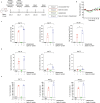The HDAC inhibitor zabadinostat is a systemic regulator of adaptive immunity
- PMID: 36702861
- PMCID: PMC9878486
- DOI: 10.1038/s42003-023-04485-y
The HDAC inhibitor zabadinostat is a systemic regulator of adaptive immunity
Abstract
Protein acetylation plays a key role in regulating cellular processes and is subject to aberrant control in diverse pathologies. Although histone deacetylase (HDAC) inhibitors are approved drugs for certain cancers, it is not known whether they can be deployed in other therapeutic contexts. We have explored the clinical HDAC inhibitor, zabadinostat/CXD101, and found that it is a stand-alone regulator of the adaptive immune response. Zabadinostat treatment increased expression of MHC class I and II genes in a variety of cells, including dendritic cells (DCs) and healthy tissue. Remarkably, zabadinostat enhanced the activity of DCs, and CD4 and CD8 T lymphocytes. Using an antigenic peptide presented to the immune system by MHC class I, zabadinostat caused an increase in antigen-specific CD8 T lymphocytes. Further, mice immunised with covid19 spike protein and treated with zabadinostat exhibit enhanced covid19 neutralising antibodies and an increased level of T lymphocytes. The enhanced humoral response reflected increased activity of T follicular helper (Tfh) cells and germinal centre (GC) B cells. Our results argue strongly that zabadinostat has potential to augment diverse therapeutic agents that act through the immune system.
© 2023. The Author(s).
Conflict of interest statement
N.L.T. is a shareholder in Celleron Therapeutics Ltd. The remaining authors declare no competing interests.
Figures







Similar articles
-
Skin dendritic cells induce follicular helper T cells and protective humoral immune responses.J Allergy Clin Immunol. 2015 Nov;136(5):1387-97.e1-7. doi: 10.1016/j.jaci.2015.04.001. Epub 2015 May 9. J Allergy Clin Immunol. 2015. PMID: 25962902 Free PMC article.
-
Immune modulation underpins the anti-cancer activity of HDAC inhibitors.Mol Oncol. 2021 Dec;15(12):3280-3298. doi: 10.1002/1878-0261.12953. Epub 2021 May 1. Mol Oncol. 2021. PMID: 33773029 Free PMC article.
-
Early T Follicular Helper Cell Responses and Germinal Center Reactions Are Associated with Viremia Control in Immunized Rhesus Macaques.J Virol. 2019 Feb 5;93(4):e01687-18. doi: 10.1128/JVI.01687-18. Print 2019 Feb 15. J Virol. 2019. PMID: 30463978 Free PMC article.
-
T cell immune response within B-cell follicles.Adv Immunol. 2019;144:155-171. doi: 10.1016/bs.ai.2019.08.008. Epub 2019 Sep 16. Adv Immunol. 2019. PMID: 31699216 Review.
-
T follicular helper cell heterogeneity: Time, space, and function.Immunol Rev. 2019 Mar;288(1):85-96. doi: 10.1111/imr.12740. Immunol Rev. 2019. PMID: 30874350 Free PMC article. Review.
Cited by
-
Dual molecule targeting HDAC6 leads to intratumoral CD4+ cytotoxic lymphocytes recruitment through MHC-II upregulation on lung cancer cells.J Immunother Cancer. 2024 Apr 11;12(4):e007588. doi: 10.1136/jitc-2023-007588. J Immunother Cancer. 2024. PMID: 38609101 Free PMC article.
-
Exosomal circ_0006896 promotes AML progression via interaction with HDAC1 and restriction of antitumor immunity.Mol Cancer. 2025 Jan 6;24(1):4. doi: 10.1186/s12943-024-02203-8. Mol Cancer. 2025. PMID: 39762891 Free PMC article.
-
Pharmacological activation of STAT1-GSDME pyroptotic circuitry reinforces epigenetic immunotherapy for hepatocellular carcinoma.Gut. 2025 Mar 6;74(4):613-627. doi: 10.1136/gutjnl-2024-332281. Gut. 2025. PMID: 39486886 Free PMC article.
-
PROTACs: A novel strategy for cancer drug discovery and development.MedComm (2020). 2023 May 29;4(3):e290. doi: 10.1002/mco2.290. eCollection 2023 Jun. MedComm (2020). 2023. PMID: 37261210 Free PMC article. Review.
-
MAP1LC3C repression reduces CIITA- and HLA class II expression in non-small cell lung cancer.PLoS One. 2025 Feb 10;20(2):e0316716. doi: 10.1371/journal.pone.0316716. eCollection 2025. PLoS One. 2025. PMID: 39928678 Free PMC article.
References
Publication types
MeSH terms
Substances
Grants and funding
LinkOut - more resources
Full Text Sources
Other Literature Sources
Medical
Research Materials
Miscellaneous

